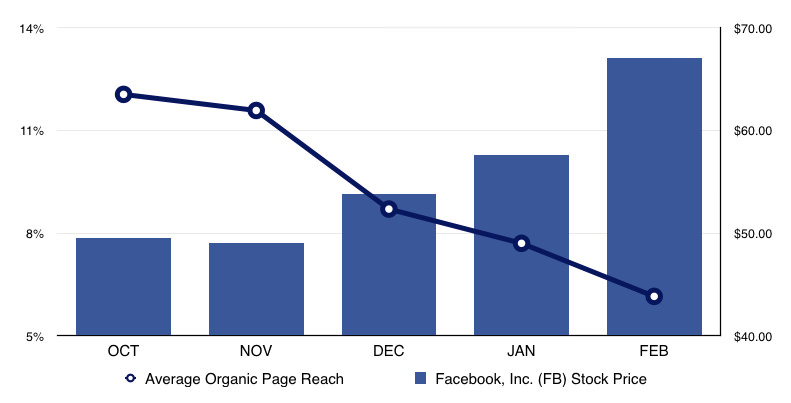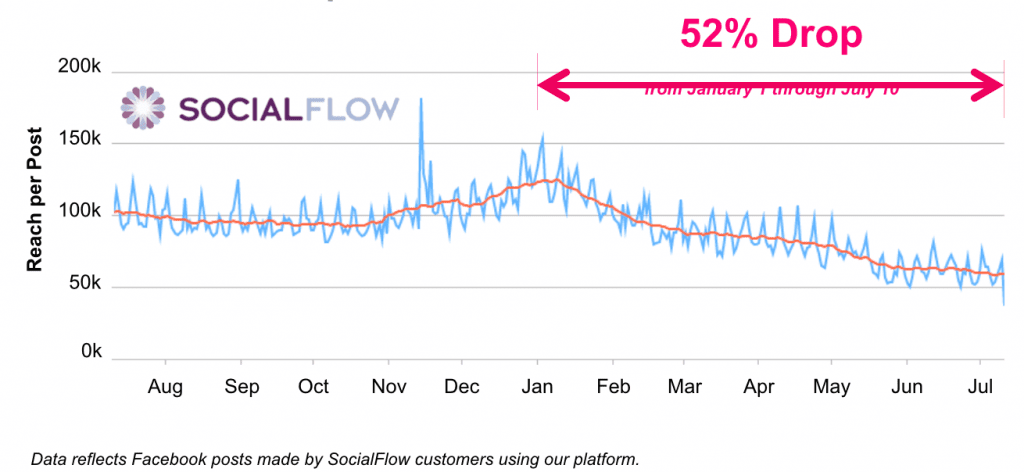If you manage a Facebook page for your business, it’s probably not surprising for you to hear that organic reach on the social network king is all but dead. What once was a thriving audience of raving fans who opted in to hear from you has most likely decreased, if not seemingly disappeared entirely.
While this certainly shouldn’t be a new discovery for you, if you’re still at a loss for what to do about it, you’re not alone.
The Decline of Organic Reach
If you’re unfamiliar with the term, organic reach is simply the audience you can reach without paying. Back in the day (2012), the formula for Facebook was simple, and it was free. If you managed to build up an audience on your page, and you posted content to your page, in all likelihood your audience would see it. As of a few years ago, this began to change very quickly.
My favorite visualization of this is still Convince and Convert’s perfect “Reachpocalypse” graphic from 2013-2014.
Basically, as the average organic reach goes down, Facebook’s stock price goes up. It’s not rocket science – by forcing people to pay to play, Facebook makes more money.
More recently, an algorithm change at the beginning of 2016 made a huge negative impact on publishers, with a reported drop of more than 50% in organic reach from January to July of 2016.
Why is This Happening?
The first, and most obvious answer to this question, is revenue. If you depend on Facebook to reach your audience, as virtually every brand in the world does, it’s not as simple as saying “I can live without Facebook.” You’re going to pay to play, and Facebook is going to reap the reward. Facebook is a for-profit company run by a lot of smart people. Again, this shouldn’t be a huge surprise.
The second answer, which is also the one provided by Facebook, is that there is far, far, far too much content for it all to be available organically. Consider this quote from Brian Boland, VP of Advertising Technology at Facebook: “On average, there are 1,500 stories that could appear in a person’s News Feed each time they log onto Facebook. For people with lots of friends and Page likes, as many as 15,000 potential stories could appear any time they log on.”
This overflow of content leads to the dreaded algorithm, in which Facebook works to predict what is most relevant to specific users. Thousands upon thousands of individual factors play into what shows on someone’s specific feed.
Simply put, there are too many people and brands posting too much content on Facebook for it to all be readily shown to all of your fans and followers, so Facebook decides what to show people.
How to Battle Back: Three Tips
TIP #1: The first answer to this question should always be to strive to make high-quality content that’s relevant to your audience regardless of the channel it’s being distributed on. Facebook, email, twitter, direct mail – it doesn’t matter where you’re marketing – compelling stories that are relevant to your audience are always the best first step.
The long and winding tale of organic reach on Facebook should serve as a cautionary tale – nothing in this world is free forever, and if it seems too good to be true, it probably is. Instagram is a great tool for organic reach right now. They also happen to be owned by Facebook. Don’t let the shiny new tool or network drive your strategy. Instead, focus on your content, and tweak it to fit the channels to which you are distributing.
TIP #2: A more direct solution as it relates to Facebook is to create more video content. We’ve talked at length here about facebook live, and video in general on Facebook, and the fact remains that video is a top priority for the company. That means that video content is going to receive priority in the algorithm’s pecking order. One study, which predates FB Live, shows video content getting 135% better organic reach than photo posts.
As with anything, video shouldn’t be approached blindly. High quality content can be expensive, and you want to make the most of it. You should develop all of your video content with your audience, distribution channels, goals, and long-term posting plan in mind.
TIP #3: Pay to play. Pure and simple. If you still maintain the approach that social media is a free platform, you’re living at least two years in the past, probably more.
That’s not to say that you should throw money at the problem blindly. Facebook has incredible audience tools that help you narrow down to reach the right people, and you should absolutely take advantage of them. Beyond that, you should be developing a strategy around what content you want to promote using paid advertising. Prioritize, budget, plan, and pay. Even for relatively small spends around boosting posts and ads, you’ll certainly see increases in engagement, reach, and website clicks.
What You Can Do Right Now
Start developing a content plan to feed the marketing beast, not just on Facebook, but across the digital landscape. You’re not in this alone – get in touch with us to have a conversation about how video content can become the cornerstone for your social marketing empire.




